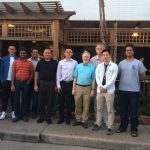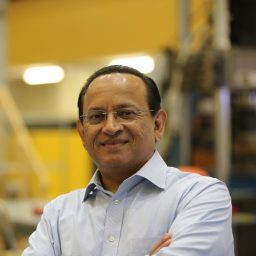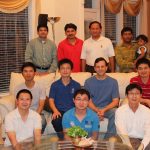Research Group Pictures: See CV for full details
Click on the Image to see it in full size





Party at Home
Test Facilities and Structural Dynamic Systems Laboratory
Vibration Testing – Shaking Table
The Ryon Engineering laboratory has two shake tables for experimental studies of structural dynamic systems. The shake tables have 15,000 lb and 4000 lb capacity and are able to simulate earthquake ground motions up to 2 g’s peak acceleration, 35 in./sec. peak velocity, and 3 in. peak displacement within a frequency range of 0 to 50 Hz. Advanced data acquisition and control systems such as dSAPACE based on MATLAB/SIMULINK are available.
NASA Truss Vibration Test Facility
Experimental studies are conducted in the Ryon Engineering Laboratory, which includes a structural test bay of about 5,000 square feet, served by a 20-ton overhead crane. A “strong floor” of 1,200 square feet is available for full scale testing. This floor has 50-kip reaction points on a three-foot grid.
NASA 8 bay truss is currently being studied to prove several new algorithms that have been developed for the NASA-TiiMS project.
Advanced data acquisition and control systems such as dSAPACE based on MATLAB/SIMULINK are available. Electromechanical shakers are available for excitation.
The high bay is also equipped with an automated computer-controlled servo hydraulic load application system with a high-speed data acquisition system capable. The test data is acquired using dSPACE and can be accessed from anywhere on CEVEnet for processing and display.
In addition, four independent closed-loop static and dynamic axial load test systems are available for material testing. Each system is equipped with hydraulic power supply, servo controllers, function generator, and a computer for controlling the test. The loading capacities of these frames vary from 22 kips to 220 kips. A considerable amount of supporting hardware is also available to facilitate testing of a variety of materials.

